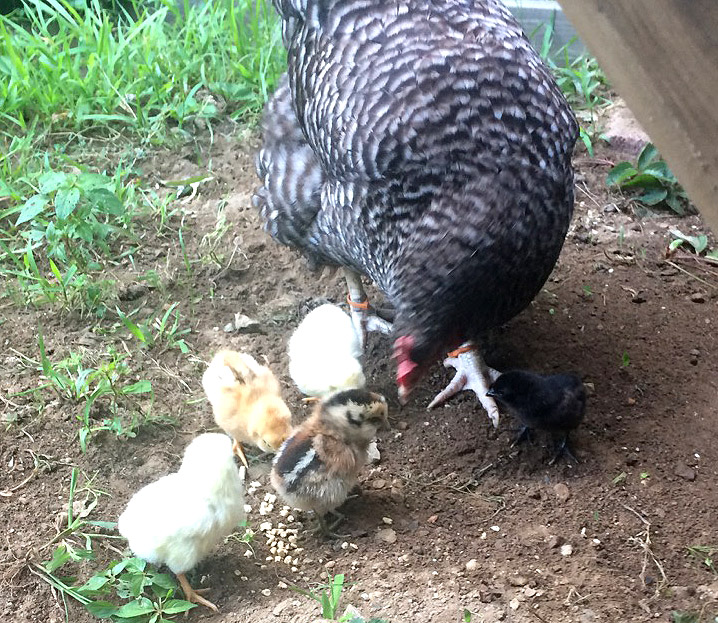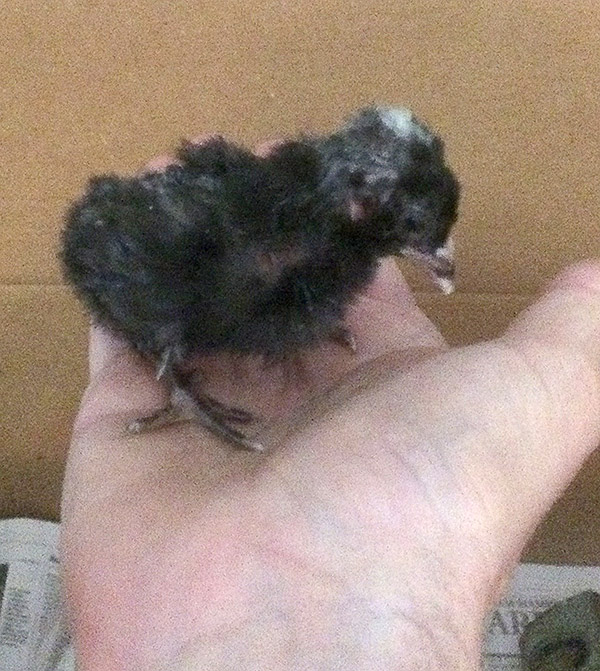
My hen “Broody” went broody again this summer. It turned out to be a complicated good-news / bad-news adventure and a good lesson in “two is one and one is none.” If you’re not interested in raising chickens, this post might not be for you. If you are contemplating a sustainable food supply, it might be of value. Read on.
The Good News: Recurring Broodiness
I was glad to see that the same hen that went broody last year decided to do so again this year. That’s great for a sustainable flock. She did not enter broodiness with the same drama as last year (The Bad Hair Days). Instead, we noticed her making the distinctive broody-cluck and sleeping on the nest. Great, right? Not really.
The Bad News: No Fertile Eggs
Our rooster was broken. Somewhere during the winter, he hurt his neck in such a way that he could not raise his head. He did not seem to be in discomfort, he just could not lift his head above his shoulders. He always appeared to be looking at the ground for something. This made him incapable of “servicing” the hens. He tried, but could not manage the “dance” effectively. One is none.
New Rooster (Eventually)
Long before Broody got the motherhood mood, I knew I needed to get a new rooster. I had bought roosters from Craig’s List years ago, but there were none listed in my area. With no fertile eggs, we could not hatch out our own replacement rooster even if we used the incubator. I ordered two rooster chicks and two hen chicks from the feed store. Sometimes chicks do not get sexed correctly so I ordered two. $3 more is cheap insurance. Two is one.
Alternate Eggs
The young roosters were growing nicely but were only three months old when Broody got the mood. They were not “into girls” yet. I did not want Broody to sit for three or four weeks and get nothing, lest it break her motherhood instinct. I needed fertile eggs from someplace else.
My first go-to source for fertile eggs would have been my pastor. He keeps a flock too. However, earlier this spring, he left his run door open one night by mistake and coyotes killed several of his chickens, including his only rooster. He had no fertile eggs to share. There were no fertile eggs listed on Craig’s List either.
Mail-order Eggs?
I knew that hatcheries shipped fertilized eggs. Many of them were sold out of varieties I wanted or had high minimum quantities. I only needed a few. Searching more, it turns out that Amazon sells fertilized chicken eggs. eBay had many listings too. The downside to mail-order eggs is the shipping delay. For best viability, an egg would be four days old (from laying) or less. Shipping requires a few days (at best). Who knows how long any of the eggs were sitting around before going in the box. The older the egg, the less likely it is to develop into a chick.

eBay
I decided to buy a dozen fertilized eggs from an eBay seller. The prices were about the same as Amazon but the eBay sellers gave better shipping times. As I mentioned above, every day matters. Even so, the eBay eggs arrived five days after I ordered them. Who knows how long they sat on the table before being shipped.
When the eggs did arrive, the seller sent fourteen instead of the dozen I ordered. Nice, but perhaps moot. I did not have high expectations.
Two Clutches, Two Broodies
Realistically, Broody could only sit on eight eggs. The other six went into the incubator. About a week before Hatch Day, a second hen started having bad hair days, screeching at her coop mates, sleeping on the nest, and doing the broody-double-cluck. She seemed pretty determined to sit, so we moved her to a quarantine pen in the garage. She balked at first (broodies don’t like change) but accepted it within a day.
In my most optimistic dreams, this second broody hen would adopt the incubator hatchlings so all chicks would be raised by a hen. The iffy part was that she would have only been sitting for a week. Would her instincts be fooled?
Hatch Day
Two days before the official hatch day (twenty-one days after starting incubation), three of Broody’s eggs hatched. She began mothering right away. The first of the incubator eggs hatched the next day.
Failed Adoption
We took that first incubator chick and placed it under Broody 2 early in the morning (still dark) as if one of her eggs hatched overnight. She didn’t fuss at the insertion. But, as the day went on, she showed no interest in the tiny chick. As it tried to follow after her, she would peck at it to make it go away. Apparently, a broody hen needs the three weeks of sitting to trigger motherliness.
Successful Placement
We put the same chick under Broody (1) early the next morning. She accepted the chick as her own. She even had one more of her eggs hatch — another chipmunk colored one. She had five chicks to mother. (See the photo at the start of this post.)
Rough Start
Of the incubator eggs, two more hatched on their own. They went into the heat-lamp box. A third one pecked a hole the size of a dime but never finished. We had given her up for dead, two days after the others had hatched. But no, she was still alive. While you’re not supposed to help chicks hatch (it usually means they’re defective anyhow), we did it anyway to give her at least a better last day of life. Her head and wing seemed glued to the shell with gooey residual white. She lost a patch of fluff where it stuck to the shell. She was weak and looked extra scruffy. So, we named her Scruff.

We did not expect her to live through the night, but she did. I, pessimistically, thought she wouldn’t last more than a day or two as she seemed too weak to eat. But, Scruff proved me wrong. She still looks really scruffy from the dried goo having matted down her fluff, but she’s eating and drinking. Go Scruff!
All told, eight of the fourteen eBay eggs hatched. One of the failed ones had a developing chick that died near the end. The others were not fertile (or too old). One was rotten. That gave the eBay eggs a 57% hatch rate. Not great, but not bad for mail-order.
Breaking the Mama Mood
Meanwhile, Broody 2 had to be coaxed to give up her broodiness. She was not going to hatch any eggs. Being broody is tough on a hen. No point in stressing her body unnecessarily. We put her back in the coop but closed off the nest boxes. She still had a day of screeching and double-clucking but seemed all over it in a couple of days.
Good Mama
Broody (1) has continued to be the good mama, taking care of her chicks, showing them chicken-ways. Last year, she was a good mother for two weeks then, abruptly, she was done. It’ll be interesting to see how long she goes this year.
Next Year?
With a functional rooster, there should be fertilized eggs. There won’t be a big need for replacement hen stock, so I’ll just wait and see if Broody does it again. If she does, fine. If not, no big deal.
Optimistically, Broody 2 will want to sit again too. Two broody hens are better than one. I’m kind of wondering if I need to keep a second rooster too — in a bachelor pad — as a hedge against “one is none.” This summer’s chick adventure has shown me that I don’t have accommodations for two broody hens to sit (apart from the others) and raise their chicks at the same time. I need to prepare for the possibility.
If times turn bad, two broody hens (and spaces for them) will be better than one. A flock that can ramp up will make a better food supply.
